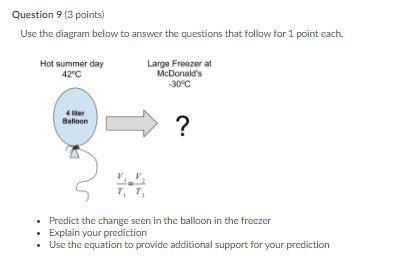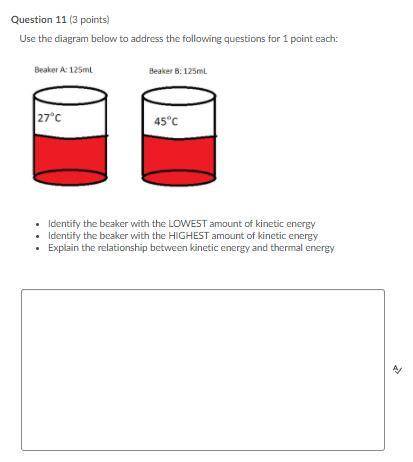BRAINLIEST - ANSWER QUICKLY
Question 1 (1 point)
Saved
Which of the followin...

Chemistry, 06.01.2021 16:10, michellemunoz250
BRAINLIEST - ANSWER QUICKLY
Question 1 (1 point)
Saved
Which of the following is the BEST evidence of a chemical change?
Question 1 options:
Two solids forming a mixture.
Two liquids forming layers instead of mixing.
Two liquids mixing to produce a precipitate.
Two liquids mixing to blend their colors.
Question 2 (1 point)
Saved
Which of the following is NOT an example of a physical change?
Question 2 options:
A metal rod bends.
A metal rod is cut into two metal rods.
A metal rod dissolves in acid.
A metal rod is stretched longer.
Question 3 (1 point)
Saved
In a cup of liquid water, when would the water molecules stop moving?
Question 3 options:
The molecules would stop moving if the liquid water in the cup became still.
The molecules would not stop moving in the cup of liquid water.
The molecules would stop moving if the liquid water in the cup became a solid.
The molecules would stop moving if the liquid water in the cup became a gas.
Question 4 (1 point)
Saved
In which state(s) of matter could a substance have thermal energy?
Question 4 options:
Only liquids and gases
Only liquids and solids
Only liquids
Liquids, solids, and gases
Question 5 (1 point)
Saved
Which of the following is NOT an example of a chemical change?
Question 5 options:
Baking soda and vinegar foam and erupt like a volcano.
Water evaporates into steam.
A hand warmer heats up after you squeeze it.
An antacid tablet neutralizes stomach acid.
Question 6 (2 points)
Saved
Question 6 options:
Boyle’s Law: When
temperature
is held constant, the pressure and volume of a gas are
inversely
proportional.
Question 7 (2 points)
Saved
Question 7 options:
Anytime that a substance changes size, shape, or temperature it would be considered a
physical
change. But, if it changed properties such as its density, pH, or how it reacts with other substances it is most likely a
chemical
change.
Question 8 (2 points)
Saved
Use the diagram below to correctly match the statements that follow.
Question 8 options:
1
Has the most kinetic energy
3
Has the least kinetic energy
1
Has an undefined volume and shape
3
Has a defined shape and volume
2
Has a defined volume but not a defined shape
1.
A
2.
B
3.
C
Question 9 (3 points)
Use the diagram below to answer the questions that follow for 1 point each.
Predict the change seen in the balloon in the freezer
Explain your prediction
Use the equation to provide additional support for your prediction
Question 9 options:
Question 10 (3 points)
Use the diagram below to answer the questions that follow for 1 point each.
Define Boyle's Law as demonstrated in the graph above
Predict the pressure if the volume is at 100
Predict the volume if the pressure is at 80 Kpa
Question 10 options:
Question 11 (3 points)
Use the diagram below to address the following questions for 1 point each:
Identify the beaker with the LOWEST amount of kinetic energy
Identify the beaker with the HIGHEST amount of kinetic energy
Explain the relationship between kinetic energy and thermal energy
Question 11 options:
Question 12 (6 points)
A balloon holds 50.0 mL of nitrogen at 25° C and a pressure of 736 mm Hg.
Answer the following questions for 2 points each:
According to Boyle's Law, what would have to change to double the pressure in the balloon?
According to Charles' Law, what would have to change to double the volume of the balloon?
Explain how the kinetic energy of molecules explains both Boyle's and Charles' Laws.





Answers: 1
Other questions on the subject: Chemistry

Chemistry, 22.06.2019 07:00, uniqueray33
What effect does a decrease in temperature have on the overall rate of a chemical reaction? a decrease in temperature decreases . the reaction rate will
Answers: 1

Chemistry, 22.06.2019 11:30, ansuaprajita1506
Voltaic cells produce a positive overall charge. what does this indicate? a. the reaction is likely to be endothermic. b. the reaction is spontaneous. c. the reaction is not likely to occur. d. the reaction is not spontaneous.
Answers: 3

Chemistry, 22.06.2019 13:00, rome58
Lab reagent, hypothesis test. a reference solution used as a lab reagent is purported to have a concentration of 5 mg/dl. six samples are taken from this solution and the following concentrations are recorded: (5.32, 4.88, 5.10, 4.73, 5.15, 4.75) mg/dl. these six measurements are assumed to be an srs of all possible measurements from solution. they are also assumed to have a standard deviation of 0.2, a normal distributin, and a mean concentration equal to the true concentration of the solution. carry out a significance test to determine whether these six measurements provide reliable evidence that the true concentration of the solution is actually not 5 mg/dl.
Answers: 1

Chemistry, 22.06.2019 16:30, Eddie997
For the reaction shown, calculate how many moles of no2 form when each of the following completely reacts. 2n2o5(g)→4no2(g)+o2(g) part a 1.0 mol n2o5 express your answer using two significant figures. nothing mol m o l request answer part b 5.4 mol n2o5 express your answer using two significant figures.
Answers: 2
Do you know the correct answer?
Questions in other subjects:

Biology, 23.06.2019 13:00


Biology, 23.06.2019 13:00


Mathematics, 23.06.2019 13:00



Mathematics, 23.06.2019 13:00


Mathematics, 23.06.2019 13:00






